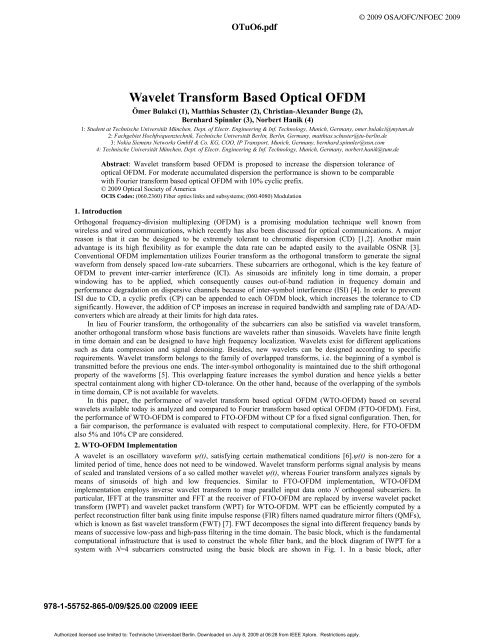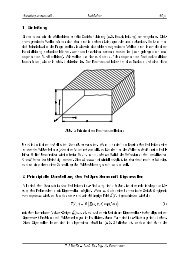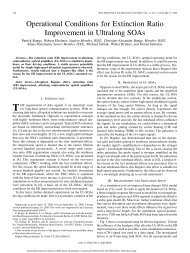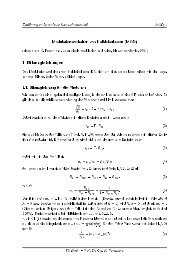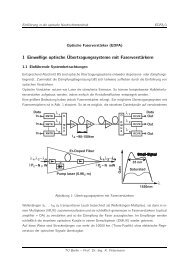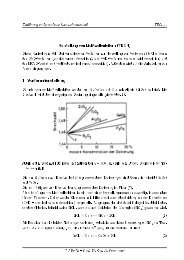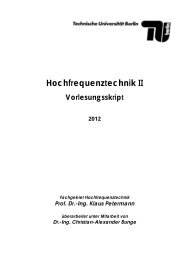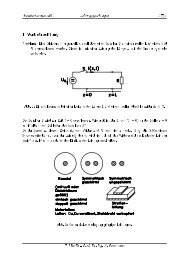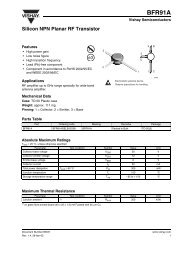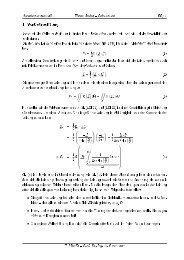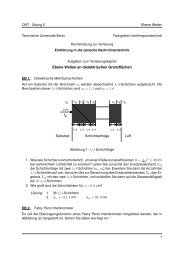Wavelet Transform Based Optical OFDM - TU Berlin
Wavelet Transform Based Optical OFDM - TU Berlin
Wavelet Transform Based Optical OFDM - TU Berlin
You also want an ePaper? Increase the reach of your titles
YUMPU automatically turns print PDFs into web optimized ePapers that Google loves.
OTuO6.pdf<br />
a1583_1.pdf<br />
© 2009 OSA/OFC/NFOEC 2009<br />
<strong>Wavelet</strong> <strong>Transform</strong> <strong>Based</strong> <strong>Optical</strong> <strong>OFDM</strong><br />
Ömer Bulakci (1), Matthias Schuster (2), Christian-Alexander Bunge (2),<br />
Bernhard Spinnler (3), Norbert Hanik (4)<br />
1: Student at Technische Universität München, Dept. of Electr. Engineering & Inf. Technology, Munich, Germany, omer.bulakci@mytum.de<br />
2: Fachgebiet Hochfrequenztechnik, Technische Universität <strong>Berlin</strong>, <strong>Berlin</strong>, Germany, matthias.schuster@tu-berlin.de<br />
3: Nokia Siemens Networks GmbH & Co. KG, COO, IP Transport, Munich, Germany, bernhard.spinnler@nsn.com<br />
4: Technische Universität München, Dept. of Electr. Engineering & Inf. Technology, Munich, Germany, norbert.hanik@tum.de<br />
Abstract: <strong>Wavelet</strong> transform based <strong>OFDM</strong> is proposed to increase the dispersion tolerance of<br />
optical <strong>OFDM</strong>. For moderate accumulated dispersion the performance is shown to be comparable<br />
with Fourier transform based optical <strong>OFDM</strong> with 10% cyclic prefix.<br />
© 2009 <strong>Optical</strong> Society of America<br />
OCIS Codes: (060.2360) Fiber optics links and subsystems; (060.4080) Modulation<br />
1. Introduction<br />
Orthogonal frequency-division multiplexing (<strong>OFDM</strong>) is a promising modulation technique well known from<br />
wireless and wired communications, which recently has also been discussed for optical communications. A major<br />
reason is that it can be designed to be extremely tolerant to chromatic dispersion (CD) [1,2]. Another main<br />
advantage is its high flexibility as for example the data rate can be adapted easily to the available OSNR [3].<br />
Conventional <strong>OFDM</strong> implementation utilizes Fourier transform as the orthogonal transform to generate the signal<br />
waveform from densely spaced low-rate subcarriers. These subcarriers are orthogonal, which is the key feature of<br />
<strong>OFDM</strong> to prevent inter-carrier interference (ICI). As sinusoids are infinitely long in time domain, a proper<br />
windowing has to be applied, which consequently causes out-of-band radiation in frequency domain and<br />
performance degradation on dispersive channels because of inter-symbol interference (ISI) [4]. In order to prevent<br />
ISI due to CD, a cyclic prefix (CP) can be appended to each <strong>OFDM</strong> block, which increases the tolerance to CD<br />
significantly. However, the addition of CP imposes an increase in required bandwidth and sampling rate of DA/ADconverters<br />
which are already at their limits for high data rates.<br />
In lieu of Fourier transform, the orthogonality of the subcarriers can also be satisfied via wavelet transform,<br />
another orthogonal transform whose basis functions are wavelets rather than sinusoids. <strong>Wavelet</strong>s have finite length<br />
in time domain and can be designed to have high frequency localization. <strong>Wavelet</strong>s exist for different applications<br />
such as data compression and signal denoising. Besides, new wavelets can be designed according to specific<br />
requirements. <strong>Wavelet</strong> transform belongs to the family of overlapped transforms, i.e. the beginning of a symbol is<br />
transmitted before the previous one ends. The inter-symbol orthogonality is maintained due to the shift orthogonal<br />
property of the waveforms [5]. This overlapping feature increases the symbol duration and hence yields a better<br />
spectral containment along with higher CD-tolerance. On the other hand, because of the overlapping of the symbols<br />
in time domain, CP is not available for wavelets.<br />
In this paper, the performance of wavelet transform based optical <strong>OFDM</strong> (WTO-<strong>OFDM</strong>) based on several<br />
wavelets available today is analyzed and compared to Fourier transform based optical <strong>OFDM</strong> (FTO-<strong>OFDM</strong>). First,<br />
the performance of WTO-<strong>OFDM</strong> is compared to FTO-<strong>OFDM</strong> without CP for a fixed signal configuration. Then, for<br />
a fair comparison, the performance is evaluated with respect to computational complexity. Here, for FTO-<strong>OFDM</strong><br />
also 5% and 10% CP are considered.<br />
2. WTO-<strong>OFDM</strong> Implementation<br />
A wavelet is an oscillatory waveform (t), satisfying certain mathematical conditions [6].(t) is non-zero for a<br />
limited period of time, hence does not need to be windowed. <strong>Wavelet</strong> transform performs signal analysis by means<br />
of scaled and translated versions of a so called mother wavelet (t), whereas Fourier transform analyzes signals by<br />
means of sinusoids of high and low frequencies. Similar to FTO-<strong>OFDM</strong> implementation, WTO-<strong>OFDM</strong><br />
implementation employs inverse wavelet transform to map parallel input data onto N orthogonal subcarriers. In<br />
particular, IFFT at the transmitter and FFT at the receiver of FTO-<strong>OFDM</strong> are replaced by inverse wavelet packet<br />
transform (IWPT) and wavelet packet transform (WPT) for WTO-<strong>OFDM</strong>. WPT can be efficiently computed by a<br />
perfect reconstruction filter bank using finite impulse response (FIR) filters named quadrature mirror filters (QMFs),<br />
which is known as fast wavelet transform (FWT) [7]. FWT decomposes the signal into different frequency bands by<br />
means of successive low-pass and high-pass filtering in the time domain. The basic block, which is the fundamental<br />
computational infrastructure that is used to construct the whole filter bank, and the block diagram of IWPT for a<br />
system with N=4 subcarriers constructed using the basic block are shown in Fig. 1. In a basic block, after<br />
978-1-55752-865-0/09/$25.00 ©2009 IEEE<br />
Authorized licensed use limited to: Technische Universitaet <strong>Berlin</strong>. Downloaded on July 8, 2009 at 06:28 from IEEE Xplore. Restrictions apply.
OTuO6.pdf<br />
a1583_1.pdf<br />
© 2009 OSA/OFC/NFOEC 2009<br />
upsampling by a factor of two at each branch, high-pass filtering is done by the half-band high-pass QMF g[n] and<br />
low-pass filtering is done by the half-band low-pass QMF h[n]. The QMFs are interdependent and for the forward<br />
transform the time reversed versions, i.e. g[-n] and h[-n] are used. The number of subcarriers N is determined by the<br />
number of levels m as N=2 m . Therefore, the knowledge of m and the coefficients of any of the QMFs are sufficient<br />
for the implementation of the transform. The overlapping feature of WTO-<strong>OFDM</strong> both in time and frequency<br />
domain is illustrated in Fig. 1a. This feature enables another degree of freedom in addition to the number of<br />
subcarriers compared to FTO-<strong>OFDM</strong>; the symbol duration can be controlled by the QMF impulse response. Besides,<br />
for longer QMFs the spectrum of each subcarrier becomes steeper, which results in further increase in CD-tolerance.<br />
3. Complexity Estimation of FTO-<strong>OFDM</strong> and WTO-<strong>OFDM</strong><br />
As the complexity measure, the total required number of complex multiplications is considered. For FTO-<strong>OFDM</strong>,<br />
the complexity of FFT is known to be<br />
C FFT<br />
N log 2<br />
( N ) . (1)<br />
For WTO-<strong>OFDM</strong>, the total complexity can be calculated starting from the complexity of a basic block. In one<br />
basic block the complexity is C BB =L due to convolutions between complex input data and real QMFs, given L as the<br />
QMF length. In an N-subcarrier filter bank there are N-1 autonomous basic blocks. Hence, the complexity of WPT is<br />
C WPT<br />
( N 1)<br />
L . (2)<br />
On the other hand, oversampling is applied in signal generation to achieve tighter spectral control of the <strong>OFDM</strong><br />
signal and to avoid aliasing. Oversampling is also important in complexity calculations, since the branches that are<br />
not required because of zero padding can be pruned, which can decrease the complexity remarkably. In our<br />
simulations, two times oversampling is used, which indicates that the number of data subcarriers N s is equal to N/2<br />
and the remaining subcarriers are set to zero. In this configuration, for WTO-<strong>OFDM</strong> implementation the lower half<br />
of the filter bank is not used and can be pruned resulting in 50% complexity reduction. For FFT it is shown in [8]<br />
that the savings of pruning over full length FFT becomes minimal for N s N/2. In addition, considering the<br />
traditional butterfly implementation of FFT, only in the last stage the number of multiplications can be decreased,<br />
which corresponds to N/2 less multiplications. Hence, the complexity of pruned-FFT becomes<br />
CFFT<br />
pruned<br />
N<br />
log 2<br />
( N ) N 2 . (3)<br />
4. Simulation Results and Discussion<br />
Simulations were carried out to evaluate a 112 Gbit/s Polmux-<strong>OFDM</strong> system. Here, only one polarization channel at<br />
a data rate of 56 Gbit/s is considered, which is generated by filling the bandwidth of 28 GHz with QPSK-modulated<br />
subcarriers. After generation, the signal is modulated onto an optical carrier with f 0 =193.1 THz using an ideal optical<br />
IQ-modulator. The signal is transmitted over a linear optical fiber adding a certain amount of CD. At the receiver,<br />
the required OSNR for BER=10 -3 is determined by noise loading. The receiver employs an optical 10 th -order<br />
Gaussian filter of 30.8 GHz FWHM bandwidth. After coherent detection, the signal is demodulated in the <strong>OFDM</strong><br />
receiver including equalization. Influences of DA- and AD-converters are not considered. The number of subcarriers<br />
was varied, which is proportional to computational complexity.<br />
In Fig. 2, the required OSNR vs. chromatic dispersion is shown for N s =64 data subcarriers for FTO-<strong>OFDM</strong><br />
without CP and WTO-<strong>OFDM</strong> for different wavelets. Each wavelet is identified by its family name followed by the<br />
(a)<br />
(b)<br />
Fig. 1. (a) Basic block and (b) IWPT for 4 subcarriers. <strong>Wavelet</strong><br />
<strong>OFDM</strong> symbols overlap both in time and frequency domain and<br />
have longer symbol duration depending on the filter length.<br />
Fig. 2. WTO-<strong>OFDM</strong> can outperform FTO-<strong>OFDM</strong> (without CP)<br />
remarkably in CD-tolerance. N S = 64.<br />
Authorized licensed use limited to: Technische Universitaet <strong>Berlin</strong>. Downloaded on July 8, 2009 at 06:28 from IEEE Xplore. Restrictions apply.
OTuO6.pdf<br />
a1583_1.pdf<br />
© 2009 OSA/OFC/NFOEC 2009<br />
maximum<br />
CD-tolerance<br />
(a)<br />
(b)<br />
Fig. 3. (a) <strong>Wavelet</strong>s show a significant reduced complexity in limited window of chromatic dispersion, (b) maximum CDtolerance<br />
vs QMF length curves of WTO-<strong>OFDM</strong> for Coiflet, Battle [6] and Johnston wavelet families.<br />
order of the wavelet. For the Johnston family [9], the integer and decimal parts denote the length of the associated<br />
QMF and the constraint group used in the design, respectively. For the Daubechies (db) [6] and Smith families [9]<br />
the order is equal to the length of the associated QMF. Noise tolerance of WTO-<strong>OFDM</strong> based on longer QMFs is<br />
slightly better than FTO-<strong>OFDM</strong>. CD-tolerance is measured at 1 dB OSNR penalty with respect to the minimum<br />
required OSNR value. Accordingly, CD-tolerance of WTO-<strong>OFDM</strong> based on longer QMFs outperforms FTO-<br />
<strong>OFDM</strong>. WTO-<strong>OFDM</strong> (Johnston 64.5) shows the superior performance and has a CD tolerance which is 5.6 times<br />
that of FTO-<strong>OFDM</strong>, achieving an absolute value of 3380 ps/nm in CD tolerance.<br />
As the computational complexity of the realizations given in Fig. 2 differs, to ensure a fair comparison, the CDtolerance<br />
comparison is also made with taking the complexities into account. The complexity versus CD-tolerance<br />
curves are presented in Fig. 3a. Since the Johnston family has superior performance compared to other considered<br />
wavelets, the comparison results are shown for the Johnston family only. A complexity reduction by a factor of 6 to<br />
10 compared to FTO-<strong>OFDM</strong> without CP can be identified for the different wavelets in the range of moderate<br />
accumulated dispersion. In Fig. 3a, the useful application areas of FTO-<strong>OFDM</strong> without CP and WTO-<strong>OFDM</strong> are<br />
labeled by Fourier regime and wavelet regime, respectively. The border of wavelet regime can be enlarged by using<br />
Johnston 64.5 at cost of increased complexity in the low complexity range compared to Johnston 32.5. As CP<br />
addition is a method to increase the CD tolerance, the results are also compared to FTO-<strong>OFDM</strong> with 5% and 10%<br />
CP. An advantage of CP is that it does not increase the computational complexity; however, it counts for the<br />
analogue bandwidth requirements. Even for CP of 10%, the results show a comparable performance up to about<br />
2300 ps/nm and 3400 ps/nm for the different wavelets. This suggests using the considered wavelets for dispersion<br />
compensated systems or short-haul communications to achieve remarkable complexity reductions.<br />
The CD value above which the CD-tolerance of WTO-<strong>OFDM</strong> starts saturating is defined as the maximum CDtolerance<br />
and is labeled for Johnston 64.5 in Fig. 3a. It can be seen from Fig. 3b that the maximum CD-tolerance<br />
within a family increases with the QMF length. In addition, for the same QMF length different wavelet families can<br />
achieve better CD-tolerance, which is the motivation to search for different wavelet families.<br />
5. Conclusions and Outlook<br />
WTO-<strong>OFDM</strong> was shown to give a remarkable benefit in complexity compared to FTO-<strong>OFDM</strong> for equal CD<br />
tolerance in the range of moderate accumulated dispersion. No overhead like CP is used. The achieved CD<br />
tolerances allow a reduction in either up to 10 times the complexity or 10% bandwidth for dispersion compensated<br />
systems or short-haul communications.<br />
The wavelet diversity can be exploited further to obtain longer wavelets in the considered families where the<br />
dispersion tolerance can be expected to increase. Moreover, different wavelet families not analyzed yet in this<br />
investigation even may have significantly better performance.<br />
References<br />
[1] A. J Lowery et al., “Performance of <strong>Optical</strong> <strong>OFDM</strong> in Ultralong-Haul …”, J. of Lightwave Technol. ,Vol. 25, No. 1 , pp. 131-138, 2007.<br />
[2] S. L. Jansen et al., “Coherent <strong>Optical</strong> 25.8-Gb/s <strong>OFDM</strong> …”, J. of Lightwave Technol., IEEE/OSA, Vol. 26, No. 1, pp.6-15, 2008.<br />
[3] S. A. Bocoi et al., “Cost Comparison of Networks Using Traditional 10 and 40 Gb/s Transponders Versus <strong>OFDM</strong> …,” OFC 2008, OThB4.<br />
[4] S. Sandberg et al., “Overlapped discrete multitone …”, Selected Areas in Communications, IEEE , Vol. 13, No. 9, pp. 1571–1585, 1995.<br />
[5] A. Jamin et al.,“ <strong>Wavelet</strong> packet modulation …”, Wireless Comm.& Mobile Computing, Wiley, Vol. 5, No. 2, pp. 123–137, 2005.<br />
[6] I. Daubechies, Ten Lectures on <strong>Wavelet</strong>s ,SIAM Publications, 1992.<br />
[7] S. Mallat, A <strong>Wavelet</strong> Tour of Signal Processing. Academic Press, 1999.<br />
[8] H. Sorensen et al., “Efficient computation of the DFT …” Signal Processing, IEEE Transactions on, Vol. 41, No. 3, pp. 1184–1200, 1993.<br />
[9] A. Akansu et al., Multiresolution Signal Decomposition: <strong>Transform</strong>s, Subbands, and <strong>Wavelet</strong>s, Academic Press, 2001.<br />
Authorized licensed use limited to: Technische Universitaet <strong>Berlin</strong>. Downloaded on July 8, 2009 at 06:28 from IEEE Xplore. Restrictions apply.


